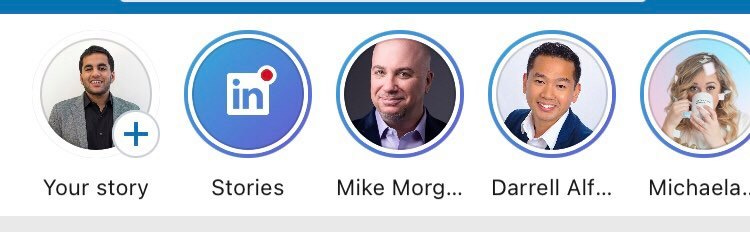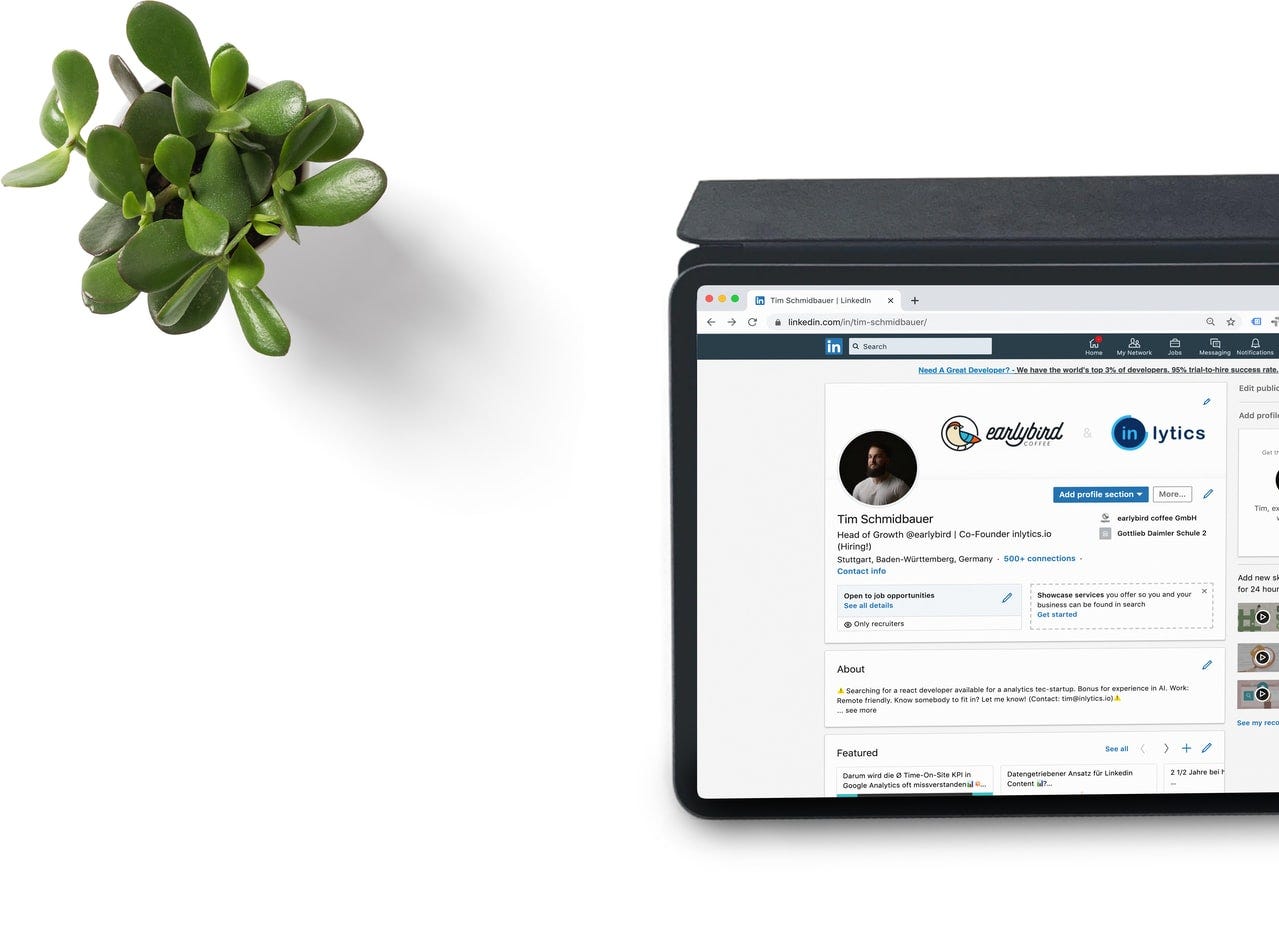Will Linkedin Stories Catch On?
Linkedin made a big splash with its first redesign in years - but will Linkedin Stories reach their potential?
Quarantine leading to big existential changes is nothing new.
Linkedin has becomes its latest victim, recently taking the wrapping off its first large redesign in almost four years.
Now, there are lots of things Linkedin could fix - better filters for job searching, more variety in a feed full of aphorisms, dark patterns in direct messages, and that weird thing where the algorithm sends you job recommendations pretending you’re the second reincarnation of Jeff Bezos.
But, Linkedin ended up rolling out a long-rumored version of its own Stories - the popular, ephemeral video and photo vignettes that have become a major engagement engine on Snapchat, Instagram and Facebook.
Now - to caveat, I’ve been on Linkedin for a few years, have blogged and posted on it, and have even used it aggressively during job hunts. I’m aware of both its utility as well as well as its reputation as a hotbed for posts like these:
The “feel good story of questionable truth with the main goal to pat oneself on the back for basic humanity” is a cornerstone of Linkedin and one that has earned the platform some light ridicule - both for being a bit over the top and a favorite of some narcissists masquerading behind “thought leadership”.
So, when Linkedin launched stories, the question was on everyone’s mind - is this a platform where stories make sense?
What are Linkedin Stories?
Let’s step back to the first order question - what are Linkedin stories?
The UI is steeped in familiarity - if you’ve used Facebook or Instagram, you’ve seen the row of circles at the top, all users sharing a glimpse into their lives.
Stories are short-lived, usually a day, and are meant to share a quick insight or visual, no more than 20-30 seconds. Linkedin doesn’t have the suite of effects Instagram provides users for its stories but they do a have relatively solid starter product - allowing mentions, texts, calendars, and community events appended to a short video recording.
So in many respects, Linkedin Stories should have no issue catching on for people who use Facebook and Instagram stories frequently, right?
Same UI, same general concept, what could go wrong?
It’s too early to tell for sure, but let’s explore.
Will Linkedin Stories be popular?
There are many subjective ways this could go - but I just recent finished reading Contagious by Professor Jonah Berger with a handful of Marketing twitter friends (yes, I’m absolutely a nerd who has marketing twitter friends and they are lovely) - given the context, I thought a good framework for marketability is the STEPPS framework he shares in Contagious.
Berger asks the high-level question: How do ideas catch on?
With that in mind, he uses both his internal research and external research to propose a general breakdown of motivations for why a product can catch on: Social currency, triggers, emotion, public, practical value, and stories.
Here’s a quick overview on what each represents:
So, in a world where Linkedin Stories explodes in popularity, what would be the motivation?
Let’s explore each.
Social Currency: Is there an inner remarkability associated with Linkedin stories? As the third large story product to market (post Snap, Facebook, and Instagram), the concept of stories isn’t new, nor does it prompt additional curiosity as to what a story is. Like TikTok, there is no embedded music, transition or sense of camaraderie around challenges. Similarly, Linkedin is a popular enough platform that being a frequent user on it doesn’t grant you a particularly lucrative image as an “insider”. So social currency is likely not a good motivation for using Linkedin stories.
Triggers: One of the most fascinating concepts in marketing is triggers, namely how routines in our day to day lives can naturally lead us to certain products. One of the reasons Instagram and Facebook have become so popular is simply because they cover a portfolio of emotional triggers - you go on Facebook when you’re bored. When you’re happy. When you’re sad. When you’re lonely. Same with Instagram - Instagram stories are powerful because people are simply on Instagram every day. They naturally watch stories out of boredom, loneliness, or excitement.
Linkedin is different. How many people scroll Linkedin out of boredom? Or choose Linkedin over its slew of competitive social networks? Translate the same value to someone simply searching for a job or a connection with a very high intent or goal to be on the platform is challenging; on one hand, you have an audience that may not have a specific goal outside of entertainment (i.e. TikTok, Instagram) and trying to use the same process to cater to Linkedin, where visits tend to be short and goals tend to be a bit more tangible. There’s no day to day emotion that leads us to Linkedin frequently. In addition, Linkedin, for many, is a seasonal platform or conditional one. Most social networks also don’t have a lot of external daily triggers (i.e. getting coffee or cooking dinner doesn’t automatically make you want to go on Linkedin) - so this is hard to quantify here.
Emotion: Emotion describes things that spread because they’re particularly evocative - inspire awe, happiness, or deep sympathy. It’s rare that many stories do this. They’re simply too short. TikToks are a simple example of consistency in emotion - people watch them because they’re funny, corny, informative, or creates a new somatic relationship with a song. Maybe Linkedin can do this one day? But I would bet my bottom dollar that no one who is in need of a quick dose of laughter is gunning to jump on Linkedin Stories.
Public: Is everyone using Linkedin stories? On the first week it came out, I posted a quick Twitter poll. Decently small sample size but yikes - it sounds like it is a hard no for lots of people who I’m friends with on Twitter.
So I went on Linkedin and looked at who was posting stories. Very few stories I saw weren’t already Linkedin influencers prior to Stories coming out (naturally, it’s the people with the highest built-in audience) and the few friends I saw sharing were simply sharing to “check out” Linkedin stories. I saw very few post again. In fact, most of my feed at the top now is second degree connections, very few that I’m even directly connected with.
Public motivations are simply a test of social proof - most humans will do stuff if they see everyone around them doing it. So how can Linkedin pull the average person who doesn’t have thousands of followers on Linkedin to use stories? As long as it remains in the upper echelon of Linkedin users, it’s going to be hard for it to compound to more.
Practical Value: This is a hard one because I feel like this is where Linkedin and Instagram can really diverge. Even on certain days where it feels like a caricature of business architects - Linkedin is full of practical value. There’s business advice, life advice, jobs, quotes, services, product promotions - in many ways, Linkedin’s beauty is in its purely practical value. Instagram and TikTok can provide an occasional nonsensical escape, but you go to Linkedin because you many times need something or want to read something for career improvement.
Where do stories fall into this paradigm?
I flipped through some of the stories will writing this - lots of stories about pictures around working from home, some book recommendations, warnings about the pandemic, pictures of a podcast, screenshots of an event, pictures of dinner.
Some are trying to use Linkedin the same way they use Linkedin normally, sharing professional tips and anecdotes. Others are going the exact opposite direction, sharing personal anecdotes and pictures from their lives. Mixing the personal with the professional. The result is a bit of a Frankenstein-ed experience still looking for it what it wants to be. Nothing wrong with that in an early product of course - but if the practical value is missing, it’s certainly a big “Why” that story viewers want to figure out.
Stories: Ironically, stories should be a great motivator for a product literally called stories - but they’re often too short to develop a long and powerful narrative. If you do want to keep connecting stories and talking for a long time, you’ll often greet people with something like this:
—————————————————
Yikes.
Sure, maybe some people with a lot of time will sit and listen. But the natural expectation going into a “Stories product” is speed. Get to the point in 20 seconds. Long narratives are almost the anti-thesis of why a stories product exist - these are for Youtube and Netflix. Very few products valued for their ephemeral nature are going to be in it for the narratives.
So we went over every aspect of the STEPPS framework: Social currency, triggers, emotion, public, practical value, and stories.
It doesn’t sound like Linkedin Stories really fits any motivation perfectly.
It’s a product without a clear viewer audience.
Given all this, there’s a small chance it could have the impact it envisions. So no, I don’t ultimately think it will catch on.
But here are my thoughts on how it could improve:
Allow users to curate their stories feed: This is where a user can really choose whether they want practical value Linkedin vs. fun anecdotal story Linkedin. Not every Linkedin user in it for the business advice cares about their favorite thought leader’s dinner. Give them the opportunity to mute certain individuals and create something valuable for them.
Allow stories to appear within a user’s profile vs. always on top of feed: I’d be more likely to watch a story connected to a user I’m already looking at vs. a group of random strangers, some of whom I’m not even connected to.
Add some opportunity for camaraderie: TikTok has really hit the “public” factor good - if you see a challenge trending, all it takes is a few people doing the challenge to make you feel like you’re missing out. Linkedin stories don’t have any sense of loss aversion at not using them.
Add some more organization to Linkedin DMs: This really has nothing to do with stories but this is in the off chance that someone at Linkedin sees this piece - do it!








